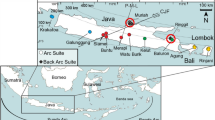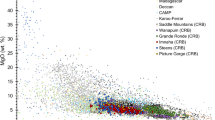Abstract
Basaltic lavas from the Three Sisters and Dalles Lakes were erupted from two isolated vents in the central Washington Cascades at 370–400 ka and 2.2 Ma, respectively, and have distinct trace element compositions that exemplify an important and poorly understood feature of arc basalts. The Three Sisters lavas are calc-alkaline basalts (CAB) with trace element compositions typical of most arc magmas: high ratios of large-ion-lithophile to high-field-strength elements (LILE/HFSE), and strong negative Nb and Ta anomalies. In contrast, the Dalles Lakes lavas have relatively low LILE/HFSE and no Nb or Ta anomalies, similar to ocean-island basalts (OIB). Nearly all Washington Cascade basalts with high to moderate incompatible element concentrations show this CAB or OIB-like compositional distinction, and there is pronounced divergence between the two magma types with a large compositional gap between them. We show that this trace element distinction can be easily explained by a simple model of flux-melting of the mantle wedge by a fluid-rich subduction component (SC), in which the degree of melting (F) of the peridotite source is correlated with the amount of SC added to it. Distinctive CAB and OIB-like trace element compositions are best explained by a flux-melting model in which dF/dSC decreases with increasing F, consistent with isenthalpic (heat-balanced) melting. In the context of this model, CAB trace element signatures simply reflect large degrees of melting of strongly SC-fluxed peridotite along relatively low dF/dSC melting trends, consistent with derivation from relatively cold mantle. Under other conditions (i.e., small degrees of melting or large degrees of melting of weakly SC-fluxed peridotite [high dF/dSC]), either OIB- or MORB (mid-ocean ridge basalt)-like compositions are produced. Trace element and isotopic compositions of Washington Cascade basalts are easily modeled by a correlation between SC and F across a range of mantle temperatures. This implies that the dominant cause of arc magmatism in this region is flux melting of the mantle wedge.
Similar content being viewed by others
Author information
Authors and Affiliations
Additional information
Received: 2 March 1999 / Accepted: 18 August 1999
Rights and permissions
About this article
Cite this article
Reiners, P., Hammond, P., McKenna, J. et al. Young basalts of the central Washington Cascades, flux melting of the mantle, and trace element signatures of primary arc magmas. Contrib Mineral Petrol 138, 249–264 (2000). https://doi.org/10.1007/s004100050561
Published:
Issue Date:
DOI: https://doi.org/10.1007/s004100050561




